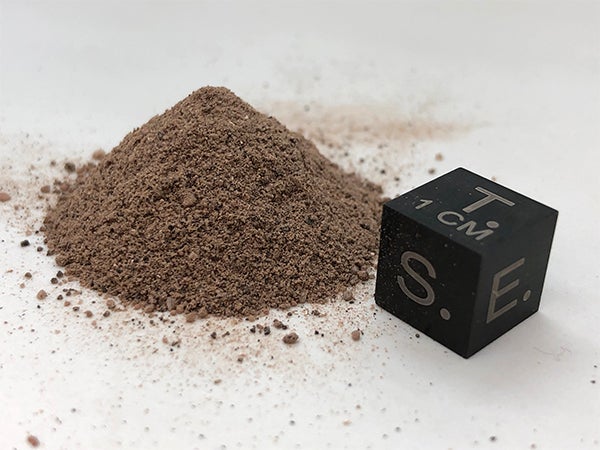Exolith Simulant: JEZ-1 Jezero Delta Simulant
Mineralogy
| Mineral | Wt.% |
|---|---|
| Olivine | 32.0 |
| Plagioclase | 16.0 |
| Glass-rich basalt | 13.5 |
| Pyroxene | 12.0 |
| Mg-carbonate | 11.0 |
| Smectite | 6.0 |
| Mg-sulfate | 2.4 |
| Ferrihydrite | 2.1 |
| Hydrated silica | 1.8 |
| Magnetite | 1.1 |
| Anhydrite | 1.0 |
| Fe-carbonate | 0.8 |
| Hematite | 0.3 |
Simulant Name: JEZ-1 Jezero Delta Simulant
Current Status: Available
Developed By: University of Central Florida
Publications: Cannon, K. M., D. T. Britt, T. M. Smith, R. F. Fritsche, and D. Batcheldor (2019), Mars Global Simulant MGS-1: A Rocknest-based Open Standard for Basaltic Martian Regolith Simulants. Icarus, 317, 470-478.
Current Status: Available
Developed By: University of Central Florida
Publications: Cannon, K. M., D. T. Britt, T. M. Smith, R. F. Fritsche, and D. Batcheldor (2019), Mars Global Simulant MGS-1: A Rocknest-based Open Standard for Basaltic Martian Regolith Simulants. Icarus, 317, 470-478.
UCF has ceased production of the simulant. The simulant is now offered by Space Resource Technologies, a spin-off company. You can reach Space Resources Technologies at the following email address: info@spaceresourcetech.com
The Jezero Delta Simulant (JEZ-1) was made to simulate anticipated materials in the Jezero Crater deltas that will be investigated by the NASA Mars 2020 rover. The simulant is a mixture of MGS-1 mineralogy with smectite clay, Mg-carbonate, and additional olivine that have all been detected from orbital remote sensing in the Jezero delta deposits.
The state of lithificaiton, mineralogy, and grain size distribution are likely variable throughout the Jezero deltas; JEZ-1 represents unconsolidated material, but can be compacted under various pressures to form a more cohesive solid.
Images
Photograph of JEZ-1:
